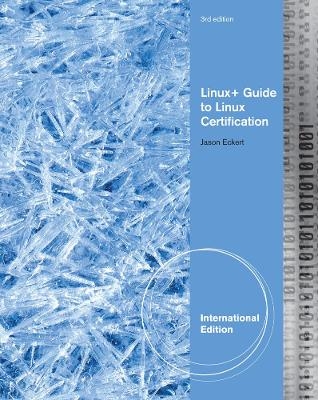
Linux+ Guide to Linux Certification, International Edition
Delmar Cengage Learning
978-1-111-54153-8 (ISBN)
- Titel z.Zt. nicht lieferbar
- Versandkostenfrei innerhalb Deutschlands
- Auch auf Rechnung
- Verfügbarkeit in der Filiale vor Ort prüfen
- Artikel merken
LINUX+ GUIDE TO LINUX CERTIFICATION, International Edition offers the most up-to-date information to empower users to successfully pass CompTIA's Linux+ (Powered by LPI) Certification exam, while maintaining a focus on quality, classroom usability, and real-world experience. This complete guide provides not only the conceptual knowledge, but also the hands-on skills necessary to work with the Linux operation systems in a network administration environment. Comprehensive coverage includes updated information pertinent to the latest Linux distributions, as well as new storage technologies such as LVM and ext4. Readers will learn about new and expanded material on key job-related networking services including FTP, NFS, Samba, Apache, DNS, DHCP, NTP, RADIUS, LDAP, Squid, Sendmail, Postfix, X, SSH, VNC, SQL, and updated information on security practices and technologies. The Hands-On Projects help learners practice new skills, and review questions and key terms reinforce important concepts.
Jason W. Eckert is an experienced technical trainer, consultant and bestselling author in the information technology industry. His diverse IT background and expertise include more than 40 IT certifications, three decades of IT and development experience, six published apps and 24 published textbooks covering such topics as UNIX, Linux®, Apache, MySQL, Windows Server, Security, Microsoft Exchange, PowerShell, BlackBerry Enterprise Server and Video Game Development. In addition, he serves as the dean of technology at triOS College, where he continues to refine and improve college technology programs. For more information, visit about.me/jasoneckert.
1. Introduction to Linux.
Operating Systems. The Linux Operating System. The History of Linux. Linux Distributions. Common Uses of Linux. Chapter Summary. Key Terms. Review Questions. Discovery Exercises.
2. Linux Installation and Usage.
Gathering Pre-Installation Information. Installing Linux. Basic Linux Usage. Chapter Summary. Key Terms. Review Questions. Discovery Exercises.
3. Exploring Linux Filesystems.
The Linux Directory Structure. Viewing Files and Directories. Displaying the Contents of Text Files. Displaying the Contents of Binary Files. Searching for Text within Files. Editing Text Files. Chapter Summary. Key Terms. Review Questions. Discovery Exercises.
4. Linux Filesystem Management.
The Filesystem Hierarchy Standard. Managing Files and Directories. Finding Files. Linking Files. File and Directory Permissions. Chapter Summary. Key Terms. Review Questions. Discovery Exercises.
5. Linux Filesystem Administration.
The /dev Directory. Filesystems. Working with Disk Devices. Floppies. CDs/DVDs. HDs. Flash. ISO images. Mounting Filesystems at Boot Time. Monitoring Filesystems. Hard Disk Quotas. Chapter Summary. Key Terms. Review Questions. Discovery Exercises.
6. Advanced Installation.
RAID. Advanced Hardware Configuration. Advanced Installation Methods. troubleshooting Installation. System Recovery. Chapter Summary. Key Terms. Review Questions. Discovery Exercises.
7. Working with the BASH Shell.
Redirection & Piping. Shell Variables. Shell Scripts. Advanced Text Tools. Chapter Summary. Key Terms. Review Questions. Discovery Exercises.
8. System Initialization & X Windows.
The Boot Process. Boot Loaders. Linux Initialization & Runlevels. Linux GUI Components. Starting and Stopping X Windows. Configuring X Windows. Chapter Summary. Key Terms. Review Questions. Discovery Exercises.
9. Managing Linux Processes.
Linux Processes. Viewing Processes. Killing Processes. Process Execution. Running Processes in the Background. Process Priorities. Scheduling Commands. Chapter Summary. Key Terms. Review Questions. Discovery Exercises.
10. Common Administrative Tasks.
Printer Administration. Log File Administration. Administering Users and Groups. Chapter Summary. Key Terms. Review Questions. Discovery Exercises.
11. Compression, System Back-up, and Software Installation.
Compression. System Back-up. Software Installation. Program Documentation, Libraries & Codecs. Chapter Summary. Key Terms. Review Questions. Discovery Exercises.
12. Configuring Linux to Participate on a Network.
Networks and TCP/IP. Configuring a NIC Interface. Configuring a PPP Interface. Name Resolution. Connecting to Network Resources. Chapter Summary. Key Terms. Review Questions. Discovery Exercises.
13. Configuring Infrastructure Network Services.
Network Services Structure. Configuring DHCP. Configuring DNS. Configuring RADIUS. Configuring LDAP. Configuring NTP. Configuring NIS. Chapter Summary. Key Terms. Review Questions. Discovery Exercises.
14. Configuring File, Database, Email and Web Services.
Configuring NFS. Configuring Samba. Configuring FTP. Configuring SQL. Configuring Email. Configuring Apache. Chapter Summary. Key Terms. Review Questions. Discovery Exercises.
15. Troubleshooting, Performance & Server Security.
Troubleshooting Methodology. Resolving Common System Problems. Performance Monitoring. Customizing the Kernel. Good Security Practices. Common Security Tools. Network Security. Chapter Summary. Key Terms. Review Questions. Discovery Exercises.
Appendix A: Certification. Why get certified? Linux+ Certification Objectives.
Appendix B: GNU Public License.
Appendix C: Finding Linux Resources on the Internet.
| Erscheint lt. Verlag | 1.1.2012 |
|---|---|
| Verlagsort | Clifton Park |
| Sprache | englisch |
| Maße | 188 x 228 mm |
| Gewicht | 1290 g |
| Themenwelt | Informatik ► Betriebssysteme / Server ► Unix / Linux |
| Mathematik / Informatik ► Informatik ► Netzwerke | |
| Informatik ► Weitere Themen ► Zertifizierung | |
| ISBN-10 | 1-111-54153-1 / 1111541531 |
| ISBN-13 | 978-1-111-54153-8 / 9781111541538 |
| Zustand | Neuware |
| Haben Sie eine Frage zum Produkt? |